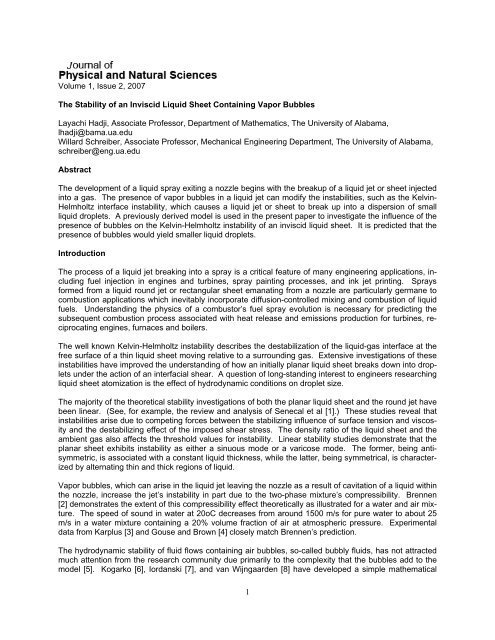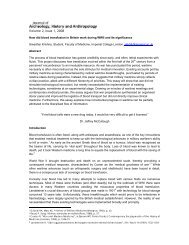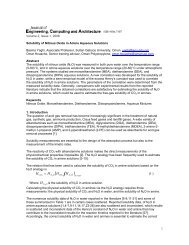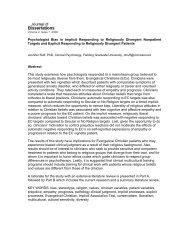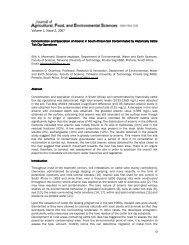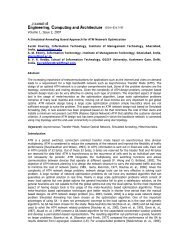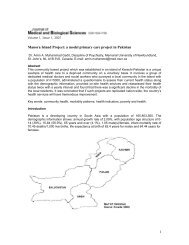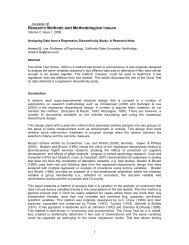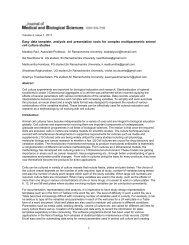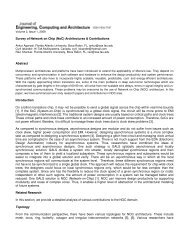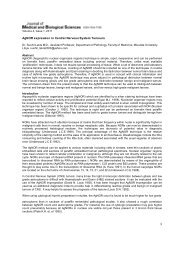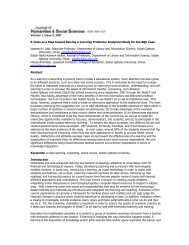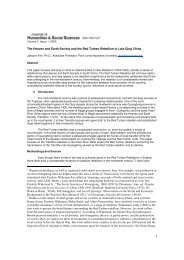The Stability of an Inviscid Liquid Sheet Containing Vapor Bubbles
The Stability of an Inviscid Liquid Sheet Containing Vapor Bubbles
The Stability of an Inviscid Liquid Sheet Containing Vapor Bubbles
Create successful ePaper yourself
Turn your PDF publications into a flip-book with our unique Google optimized e-Paper software.
Volume 1, Issue 2, 2007<br />
<strong>The</strong> <strong>Stability</strong> <strong>of</strong> <strong>an</strong> <strong>Inviscid</strong> <strong>Liquid</strong> <strong>Sheet</strong> <strong>Containing</strong> <strong>Vapor</strong> <strong>Bubbles</strong><br />
Layachi Hadji, Associate Pr<strong>of</strong>essor, Department <strong>of</strong> Mathematics, <strong>The</strong> University <strong>of</strong> Alabama,<br />
lhadji@bama.ua.edu<br />
Willard Schreiber, Associate Pr<strong>of</strong>essor, Mech<strong>an</strong>ical Engineering Department, <strong>The</strong> University <strong>of</strong> Alabama,<br />
schreiber@eng.ua.edu<br />
Abstract<br />
<strong>The</strong> development <strong>of</strong> a liquid spray exiting a nozzle begins with the breakup <strong>of</strong> a liquid jet or sheet injected<br />
into a gas. <strong>The</strong> presence <strong>of</strong> vapor bubbles in a liquid jet c<strong>an</strong> modify the instabilities, such as the Kelvin-<br />
Helmholtz interface instability, which causes a liquid jet or sheet to break up into a dispersion <strong>of</strong> small<br />
liquid droplets. A previously derived model is used in the present paper to investigate the influence <strong>of</strong> the<br />
presence <strong>of</strong> bubbles on the Kelvin-Helmholtz instability <strong>of</strong> <strong>an</strong> inviscid liquid sheet. It is predicted that the<br />
presence <strong>of</strong> bubbles would yield smaller liquid droplets.<br />
Introduction<br />
<strong>The</strong> process <strong>of</strong> a liquid jet breaking into a spray is a critical feature <strong>of</strong> m<strong>an</strong>y engineering applications, including<br />
fuel injection in engines <strong>an</strong>d turbines, spray painting processes, <strong>an</strong>d ink jet printing. Sprays<br />
formed from a liquid round jet or rect<strong>an</strong>gular sheet em<strong>an</strong>ating from a nozzle are particularly germ<strong>an</strong>e to<br />
combustion applications which inevitably incorporate diffusion-controlled mixing <strong>an</strong>d combustion <strong>of</strong> liquid<br />
fuels. Underst<strong>an</strong>ding the physics <strong>of</strong> a combustor’s fuel spray evolution is necessary for predicting the<br />
subsequent combustion process associated with heat release <strong>an</strong>d emissions production for turbines, reciprocating<br />
engines, furnaces <strong>an</strong>d boilers.<br />
<strong>The</strong> well known Kelvin-Helmholtz instability describes the destabilization <strong>of</strong> the liquid-gas interface at the<br />
free surface <strong>of</strong> a thin liquid sheet moving relative to a surrounding gas. Extensive investigations <strong>of</strong> these<br />
instabilities have improved the underst<strong>an</strong>ding <strong>of</strong> how <strong>an</strong> initially pl<strong>an</strong>ar liquid sheet breaks down into droplets<br />
under the action <strong>of</strong> <strong>an</strong> interfacial shear. A question <strong>of</strong> long-st<strong>an</strong>ding interest to engineers researching<br />
liquid sheet atomization is the effect <strong>of</strong> hydrodynamic conditions on droplet size.<br />
<strong>The</strong> majority <strong>of</strong> the theoretical stability investigations <strong>of</strong> both the pl<strong>an</strong>ar liquid sheet <strong>an</strong>d the round jet have<br />
been linear. (See, for example, the review <strong>an</strong>d <strong>an</strong>alysis <strong>of</strong> Senecal et al [1].) <strong>The</strong>se studies reveal that<br />
instabilities arise due to competing forces between the stabilizing influence <strong>of</strong> surface tension <strong>an</strong>d viscosity<br />
<strong>an</strong>d the destabilizing effect <strong>of</strong> the imposed shear stress. <strong>The</strong> density ratio <strong>of</strong> the liquid sheet <strong>an</strong>d the<br />
ambient gas also affects the threshold values for instability. Linear stability studies demonstrate that the<br />
pl<strong>an</strong>ar sheet exhibits instability as either a sinuous mode or a varicose mode. <strong>The</strong> former, being <strong>an</strong>tisymmetric,<br />
is associated with a const<strong>an</strong>t liquid thickness, while the latter, being symmetrical, is characterized<br />
by alternating thin <strong>an</strong>d thick regions <strong>of</strong> liquid.<br />
<strong>Vapor</strong> bubbles, which c<strong>an</strong> arise in the liquid jet leaving the nozzle as a result <strong>of</strong> cavitation <strong>of</strong> a liquid within<br />
the nozzle, increase the jet’s instability in part due to the two-phase mixture’s compressibility. Brennen<br />
[2] demonstrates the extent <strong>of</strong> this compressibility effect theoretically as illustrated for a water <strong>an</strong>d air mixture.<br />
<strong>The</strong> speed <strong>of</strong> sound in water at 20oC decreases from around 1500 m/s for pure water to about 25<br />
m/s in a water mixture containing a 20% volume fraction <strong>of</strong> air at atmospheric pressure. Experimental<br />
data from Karplus [3] <strong>an</strong>d Gouse <strong>an</strong>d Brown [4] closely match Brennen’s prediction.<br />
<strong>The</strong> hydrodynamic stability <strong>of</strong> fluid flows containing air bubbles, so-called bubbly fluids, has not attracted<br />
much attention from the research community due primarily to the complexity that the bubbles add to the<br />
model [5]. Kogarko [6], Iord<strong>an</strong>ski [7], <strong>an</strong>d v<strong>an</strong> Wijngaarden [8] have developed a simple mathematical<br />
1
model to describe the velocity <strong>an</strong>d pressure fields in <strong>an</strong> inviscid liquid containing a small volume fraction<br />
in bubbles. While the liquid phase is incompressible, compressibility effects arise in the fluid solely due to<br />
the presence <strong>of</strong> the bubbles, which are assumed to be small, <strong>of</strong> a spherical shape, <strong>an</strong>d to consist <strong>of</strong> a<br />
perfect gas. <strong>The</strong>se bubbles, moreover, experience no slip with the moving fluid <strong>an</strong>d do not interact with<br />
each other. <strong>The</strong> model is described by a single velocity field even though the system consists <strong>of</strong> two<br />
phases.<br />
In this paper, we <strong>an</strong>alyze the effect <strong>of</strong> compressibility on the stability <strong>of</strong> a fluid sheet that includes a small<br />
volume fraction <strong>of</strong> vapor. Linear equations are formulated that describe the effect that surface tension<br />
<strong>an</strong>d momentum have on this inviscid fluid sheet. Surface tension acts at the interface between the liquid<br />
phase <strong>an</strong>d the outside air. <strong>The</strong> surface tension at the bubbles’ surfaces as well as gravity effects are<br />
negligibly small <strong>an</strong>d thus are neglected. <strong>The</strong> results illustrate the effect <strong>of</strong> compressibility on the neutral<br />
stability curves as a function <strong>of</strong> the Weber number, wave number, <strong>an</strong>d density ratio.<br />
<strong>The</strong> model used in this paper is attributable to Kogorko [6], Iord<strong>an</strong>ski [7], <strong>an</strong>d v<strong>an</strong> Wijngaarden [8] <strong>an</strong>d<br />
accounts for the presence <strong>of</strong> a gas phase surrounding the moving bubbly liquid sheet. <strong>The</strong> Weber number,<br />
which describes the ratio <strong>of</strong> inertial to surface tension forces, the ratio <strong>of</strong> gas <strong>an</strong>d liquid density, <strong>an</strong>d<br />
the speed <strong>of</strong> sound in the liquid mixture constitute the parameters which govern the problem <strong>of</strong> bubbly<br />
liquid break up. When bubble concentration in the liquid is increased slightly above zero, the sound <strong>of</strong><br />
speed decreases sharply. A complex dispersion relation is derived, the <strong>an</strong>alysis <strong>of</strong> which demonstrates<br />
that the presence <strong>of</strong> bubbles in the liquid does not modify the threshold for the onset <strong>of</strong> the Kelvin-<br />
Helmholtz instability. <strong>The</strong> instability onset occurs at a zero Weber number, with or without the presence<br />
<strong>of</strong> bubbles; however, the presence <strong>of</strong> a minute amount <strong>of</strong> bubbles in the liquid c<strong>an</strong> drastically alter the<br />
critical wavenumber. More precisely, it is found that the critical wavenumber increases with the concentration<br />
level <strong>of</strong> bubbles in the liquid. If the initial size <strong>of</strong> the droplets in the spray following breakup is correlated<br />
with the critical wavelength, our findings imply that the presence <strong>of</strong> bubbles would cause smaller<br />
liquid droplets.<br />
Formulation<br />
An inviscid liquid sheet, moving with a velocity Uo, contains a small volume fraction <strong>of</strong> spherical bubbles,<br />
the concentration <strong>of</strong> which is conserved. <strong>The</strong> bubbles are assumed not to interact with each other <strong>an</strong>d<br />
have no interphase velocity relative to the liquid phase. <strong>The</strong> mixture is viewed as a continuous medium<br />
with the liquid phase making up its mass <strong>an</strong>d the vapor content accounting for its compressibility [8].<br />
ρ ( x , z,<br />
t)<br />
p ( x,<br />
z,<br />
t)<br />
u ( x,<br />
z,<br />
t)<br />
In this tr<strong>an</strong>sient, two-dimensional model, , <strong>an</strong>d<br />
denote the average density,<br />
pressure, <strong>an</strong>d velocity. <strong>The</strong>n the fluid flow in the mixture is described by the equations <strong>of</strong> mass <strong>an</strong>d momentum<br />
conservation.<br />
( ρu) ∂( ρw)<br />
∂ρ<br />
∂<br />
+ + = 0<br />
∂t<br />
∂x<br />
∂z<br />
⎛ ∂u<br />
∂u<br />
∂u<br />
⎞ ∂p<br />
ρ⎜<br />
+ u + w ⎟ = −<br />
⎝ ∂t<br />
∂x<br />
∂z<br />
⎠ ∂x<br />
⎛ ∂w<br />
∂w<br />
∂w<br />
⎞ ∂p<br />
ρ⎜<br />
+ u + w ⎟ = −<br />
⎝ ∂t<br />
∂x<br />
∂z<br />
⎠ ∂z<br />
<strong>The</strong> pressures in the liquid <strong>an</strong>d vapor phases are related by<br />
(1)<br />
(2)<br />
(3)<br />
<strong>an</strong>d<br />
p<br />
g<br />
( R)<br />
=<br />
3γ<br />
⎛ Ro<br />
⎞<br />
po<br />
⎜ ⎟<br />
⎝ R ⎠<br />
(4)<br />
2
p<br />
g<br />
⎛<br />
2<br />
⎜<br />
d R 3 ⎛ dR ⎞<br />
− p = ρl<br />
R +<br />
2<br />
⎜ ⎟<br />
⎝ dt 2 ⎝ dt ⎠<br />
2<br />
⎞<br />
⎟<br />
⎠<br />
(5)<br />
ρ<br />
g<br />
where <strong>an</strong>d<br />
ρ<br />
l are the densities <strong>of</strong> the vapor <strong>an</strong>d liquid phases,<br />
γ<br />
is the polytropic gas exponent. <strong>The</strong> density <strong>of</strong> the mixture is given by<br />
p o<br />
is the equilibrium pressure, <strong>an</strong>d<br />
ρ<br />
⎛ 4 ⎞ 4<br />
1 − πR<br />
N ρ + πR<br />
Nρ<br />
=<br />
3<br />
3<br />
⎜ ⎟ l<br />
g<br />
⎝ 3 ⎠ 3<br />
(6)<br />
where N(x,z,t) <strong>an</strong>d R(t) represent the number <strong>of</strong> bubbles per unit volume <strong>an</strong>d the average bubble’s radius,<br />
<strong>an</strong>d the number N <strong>of</strong> bubbles is conserved.<br />
<strong>The</strong> two-dimensional liquid sheet is bounded above <strong>an</strong>d below by infinite layers <strong>of</strong> gas. On assuming that<br />
the latter is inviscid <strong>an</strong>d incompressible, the gas flow is described by<br />
∂<br />
( u ) ∂( w )<br />
a<br />
∂x<br />
+<br />
a<br />
∂z<br />
= 0<br />
(7)<br />
⎛ ∂ua<br />
ρ<br />
a ⎜<br />
⎝ ∂t<br />
⎛ ∂wa<br />
ρ<br />
a ⎜<br />
⎝ ∂t<br />
+ u<br />
a<br />
+ u<br />
a<br />
∂u<br />
a<br />
∂x<br />
∂w<br />
a<br />
∂x<br />
+ w<br />
a<br />
+ w<br />
∂u<br />
a<br />
a<br />
∂z<br />
∂w<br />
∂z<br />
⎞<br />
⎟<br />
⎠<br />
a<br />
∂pa<br />
= −<br />
∂x<br />
⎞ ∂pa<br />
⎟ = −<br />
⎠ ∂z<br />
(8)<br />
(9)<br />
where ua <strong>an</strong>d wa are the horizontal <strong>an</strong>d vertical components <strong>of</strong> the velocity, pa is the pressure, <strong>an</strong>d<br />
the density.<br />
Boundary conditions supplement the equations (1) – (5) <strong>an</strong>d (8) – (9). At the free interface located at z =<br />
ho(1+h), the application <strong>of</strong> the kinematic condition implies<br />
∂h<br />
∂h<br />
∂h<br />
∂h<br />
w = + U<br />
o<br />
+ u w a<br />
=<br />
∂t<br />
∂x<br />
∂x<br />
<strong>an</strong>d ∂t<br />
. (10)<br />
<strong>The</strong> normal stress condition yields the relation between the liquid <strong>an</strong>d air pressures <strong>an</strong>d the interface<br />
shape.<br />
ρa<br />
is<br />
2<br />
∂ h<br />
− p + pa = σ<br />
2<br />
∂x<br />
2<br />
⎡ 2<br />
⎛ ∂ h ⎞ ⎤<br />
⎢1<br />
+<br />
⎜ ⎥<br />
2<br />
⎟<br />
⎢⎣<br />
⎝ ∂x<br />
⎠ ⎥⎦<br />
3<br />
2<br />
(11)<br />
where σ is the coefficient <strong>of</strong> surface tension. At the centerline <strong>of</strong> the sheet, z = 0, either w = 0 (symmetric<br />
case) or ∂z<br />
u<br />
∂w<br />
= 0<br />
(<strong>an</strong>ti-symmetric case) is imposed. Far away from the sheet,<br />
a<br />
→ 0 p<br />
, a<br />
→ 0<br />
, <strong>an</strong>d<br />
w a<br />
→ 0<br />
.<br />
3
ρ<br />
When length, time, velocity, density, <strong>an</strong>d pressure are scaled by ho, ho/Uo, Uo,<br />
ρ U 2<br />
o , <strong>an</strong>d<br />
o o , the following<br />
dimensionless system is obtained. <strong>The</strong> system has been linearized about the pl<strong>an</strong>ar interface located<br />
at z = 1,<br />
∂ρ<br />
∂ρ<br />
∂u<br />
∂w<br />
+ + + = 0<br />
∂t<br />
∂x<br />
∂x<br />
∂z<br />
(12)<br />
∂u<br />
∂u<br />
∂p<br />
+ = −<br />
∂t<br />
∂x<br />
∂x<br />
(13)<br />
∂w<br />
∂w<br />
∂p<br />
+ = −<br />
∂t<br />
∂x<br />
∂z<br />
(14)<br />
∂ua<br />
−1 ∂pa<br />
= −Q<br />
∂t<br />
∂x<br />
(15)<br />
∂wa<br />
−1 ∂pa<br />
= −Q<br />
∂t<br />
∂z<br />
(16)<br />
∂ua<br />
∂wa<br />
+ = 0<br />
∂x<br />
∂z<br />
(17)<br />
with boundary conditions,<br />
u a<br />
∂h<br />
∂h<br />
∂h<br />
w = + w a<br />
=<br />
∂t<br />
∂x<br />
, ∂t<br />
at z = 1 (18)<br />
2<br />
−1<br />
∂ h<br />
− p + pa<br />
= We<br />
2<br />
∂x<br />
at z = 1 (19)<br />
∂w<br />
= 0<br />
w = 0 or ∂z<br />
at z = 0 (20)<br />
→ 0 p<br />
,<br />
a<br />
→ 0 w → 0<br />
, <strong>an</strong>d<br />
a<br />
as z → ∞<br />
(21)<br />
where<br />
ρ Q = a h o<br />
ρoU<br />
We =<br />
ρ<br />
<strong>an</strong>d σ<br />
2<br />
o<br />
are the density ratio <strong>an</strong>d Weber number, respectively.<br />
Gavzilyuk <strong>an</strong>d Teshukov [9] have shown that in the linear regime, the effect <strong>of</strong> the vapor phase is described<br />
by a relationship between the pressure in the liquid phase <strong>an</strong>d the density <strong>of</strong> the mixture as,<br />
2 2⎛<br />
∂<br />
p = α ρ + β ⎜<br />
⎝ ∂t<br />
∂ ⎞<br />
+ ⎟<br />
∂x<br />
⎠<br />
2<br />
ρ<br />
(22)<br />
2<br />
α =<br />
a<br />
2<br />
2<br />
U o<br />
where , the term, a, being the speed <strong>of</strong> sound in the bubbly fluid, <strong>an</strong>d representing the<br />
characteristic length scale R/Ai, Ai being the bubbles’ interfacial area. For a fluid sheet moving at ~ 100<br />
2<br />
()<br />
m/s, a ~ 100 m/s <strong>an</strong>d<br />
α = O 1<br />
.<br />
2<br />
β<br />
On introducing the potential functions, φ φ<br />
<strong>an</strong>d<br />
a defined by<br />
4
u = φ x<br />
w = φ<br />
, z<br />
φ<br />
= u<br />
φ<br />
( ) ( ) ,<br />
a x a<br />
,<br />
a z a<br />
= w<br />
; (23)<br />
the governing system reduces to<br />
Equations (25) <strong>an</strong>d (26) imply,<br />
∂ρ<br />
∂ρ<br />
2<br />
+ + ∇ φ = 0<br />
∂t ∂x<br />
(24)<br />
∂φ<br />
∂φ<br />
p = − −<br />
∂t<br />
∂x<br />
(25)<br />
2<br />
2 2⎛<br />
∂ ∂ ⎞<br />
p = α ρ + β ⎜ − ⎟ ρ<br />
⎝ ∂t<br />
∂x<br />
⎠<br />
(26)<br />
2<br />
∇ φ a<br />
= 0<br />
(27)<br />
∂φa<br />
pa<br />
= −Q<br />
∂t<br />
(28)<br />
∂φ ∂h<br />
∂h<br />
∂φa<br />
∂h<br />
= + =<br />
∂z<br />
∂t<br />
∂x<br />
, ∂z<br />
∂t<br />
at z = 1 (29)<br />
2<br />
−1<br />
∂ h<br />
− p + pa<br />
= We<br />
2<br />
∂x<br />
(30)<br />
∂φ<br />
= 0<br />
∂z<br />
(varicose) or<br />
φ = 0<br />
(sinuous) or at z = 0 (31)<br />
φ a<br />
→ 0 p → 0<br />
, <strong>an</strong>d<br />
a<br />
as z → ∞<br />
(32)<br />
2 2⎛<br />
−α<br />
ρ − β ⎜<br />
⎝<br />
∂<br />
∂<br />
2<br />
2<br />
∂ ⎞ ⎛ ∂ ∂ ⎞<br />
+ ⎟ ρ = ⎜ + ⎟ φ<br />
t ∂x<br />
⎠ ⎝ ∂t<br />
∂x<br />
⎠<br />
(33)<br />
By operating with<br />
⎛ ∂ ∂ ⎞<br />
⎜ + ⎟<br />
⎝ ∂t ∂x<br />
⎠ on both sides <strong>of</strong> equation (33) <strong>an</strong>d on using equation (24), we find,<br />
2<br />
2 2 2⎛<br />
∂ ∂ ⎞ 2 ⎛ ∂ ∂ ⎞<br />
α ∇ φ + β ⎜ + ⎟ ∇ φ = ⎜ + ⎟ φ<br />
⎝ ∂t ∂x<br />
⎠ ⎝ ∂t<br />
∂x<br />
⎠<br />
(34)<br />
<strong>The</strong> <strong>an</strong>alysis <strong>of</strong> the system consisting <strong>of</strong> equations (34) , (27), <strong>an</strong>d (28) <strong>an</strong>d boundary conditions given by<br />
equations (29) – (32) using the Fourier tr<strong>an</strong>sform,<br />
φ = ˆ φ( z ) exp( ωt<br />
+ ikx)<br />
, yields the following dispersion<br />
relation,<br />
for the varicose mode, <strong>an</strong>d<br />
2<br />
3<br />
( + ik ) 2 coth ( l) + Qlω<br />
= − lRk<br />
k ω<br />
(35)<br />
2<br />
3<br />
( + ik ) 2 t<strong>an</strong>h ( l) + Qlω<br />
= − lRk<br />
k ω<br />
(36)<br />
2<br />
5
for the sinuous mode, where<br />
⎡<br />
l = ⎢k<br />
⎣<br />
2<br />
+<br />
2<br />
α +<br />
2<br />
( ω + ik)<br />
2<br />
β ( ω + ik)<br />
2<br />
⎤<br />
⎥<br />
⎦<br />
1<br />
2<br />
(37)<br />
<strong>an</strong>d ω <strong>an</strong>d k are the growth rate <strong>an</strong>d the wavenumber, respectively.<br />
Analysis <strong>of</strong> the dispersion relations:<br />
[ ]<br />
2<br />
( ) 2 2 2<br />
( )<br />
<strong>The</strong> term<br />
+ ik / α + β ω + ik<br />
ω<br />
in Eq. (37) determines the influence <strong>of</strong> the presence <strong>of</strong> bubbles<br />
on the onset <strong>of</strong> instability. <strong>The</strong> stability characteristics c<strong>an</strong> be determined directly by solving the dispersion<br />
relation, equations (35) <strong>an</strong>d (36), for the growth rate ω as function <strong>of</strong> the wavenumber k for fixed<br />
values <strong>of</strong> the Weber number <strong>an</strong>d the density ratio Q. This approach, however, does not yield a qu<strong>an</strong>titative<br />
assessment <strong>of</strong> the wavelength <strong>of</strong> the instability. In order to isolate the main effects <strong>of</strong> the bubble’s<br />
presence, we proceed as follows.<br />
6.5<br />
Physical solution limit for alpha<br />
6<br />
5.5<br />
5<br />
alpha<br />
4.5<br />
4<br />
physical region<br />
3.5<br />
3<br />
nonphysical region<br />
2.5<br />
0 0.5 1 1.5 2 2.5 3 3.5 4<br />
k<br />
Figure 1. Plot <strong>of</strong> the line where l equals zero as a function <strong>of</strong> k <strong>an</strong>d<br />
α . <strong>The</strong> parameters Q,<br />
β , <strong>an</strong>d b<br />
are set to 0.001, 1.0, <strong>an</strong>d 1.0, respectively. When l is complex, the dispersion relations,<br />
equations (35) <strong>an</strong>d (36), are nonphysical. When l is real, the dispersion relation equations<br />
c<strong>an</strong> yield physical information about the neutral stability curve.<br />
At the onset <strong>of</strong> instability, the real part <strong>of</strong> ω is zero. Let<br />
ω =<br />
ib<br />
, where b is the frequency <strong>of</strong> oscillations<br />
at onset. If b happens to be zero as well, then the instability becomes a steady mode. On setting<br />
in equations (35), (36), <strong>an</strong>d (37), we obtain<br />
*<br />
2 coth<br />
( )<br />
( l ) 2<br />
3<br />
− k b + k − Qb = −Rk<br />
*<br />
l<br />
<strong>an</strong>d<br />
6<br />
ω = ib<br />
(38)
where<br />
− k<br />
2 t<strong>an</strong>h l<br />
*<br />
l<br />
*<br />
( )<br />
( ) 2<br />
3<br />
b + k − Qb = −Rk<br />
l<br />
*<br />
⎡<br />
= ⎢k<br />
⎣<br />
2<br />
−<br />
2<br />
α −<br />
2<br />
( k + b)<br />
2<br />
β ( k + b)<br />
(40)<br />
*<br />
*<br />
Generally, the expression for l is complex. On letting<br />
l = μ + iv<br />
, so<br />
*<br />
t<strong>an</strong>h( l )<br />
=<br />
t<strong>an</strong>h( μ + iv) *<br />
( )<br />
= p + iq<br />
l<br />
μ + iv<br />
(41)<br />
Equating the real <strong>an</strong>d imaginary parts <strong>of</strong> the dispersion relation for the varicose mode implies that<br />
2<br />
2<br />
3<br />
k ( b + k) p + Qb = + Rk<br />
(42)<br />
<strong>an</strong>d<br />
kq( b + k ) 2 = 0<br />
. (43)<br />
For a non-zero wave number, the imaginary part clearly implies that<br />
q = 0<br />
. A similar argument also<br />
yields<br />
q = 0<br />
for the sinuous mode; ie, the expression for l* is real. <strong>The</strong> region in the parameter space <strong>of</strong><br />
the problem where l* is real is termed the physical region, <strong>an</strong>d a representative case is depicted in figure<br />
1.<br />
2<br />
⎤<br />
⎥<br />
⎦<br />
1<br />
2<br />
(39)<br />
Weber number<br />
0.05<br />
0.045<br />
0.04<br />
0.035<br />
0.03<br />
0.025<br />
0.02<br />
0.015<br />
<strong>Stability</strong> curves for various alpha values<br />
6.1188<br />
3.7696<br />
3.1098<br />
2.8402<br />
no bubbles<br />
0.01<br />
0.005<br />
Figure 2.<br />
0<br />
0.1 0.2 0.3 0.4 0.5 0.6 0.7 0.8 0.9 1 1.1<br />
k<br />
Plots <strong>of</strong> a neutral stability curve for a purely liquid sheet (“no bubbles”) in a gas <strong>an</strong>d <strong>of</strong> neutral<br />
stability curves for liquid sheets, with various concentrations <strong>of</strong> bubbles as indicated by the<br />
values <strong>of</strong> α , in a gas. <strong>The</strong> sheet’s interface deformation is varicose. <strong>The</strong> parameters Q,<br />
β ,<br />
<strong>an</strong>d b are set to 0.001, 1.0, <strong>an</strong>d 1.0, respectively.<br />
7
0.2<br />
<strong>Stability</strong> curves for various alpha values<br />
0.18<br />
0.16<br />
Weber number<br />
0.14<br />
0.12<br />
0.1<br />
0.08<br />
0.06<br />
0.04<br />
6.1188<br />
3.7696<br />
3.1098<br />
no bubbles<br />
0.02<br />
Figure 3.<br />
0<br />
0 0.1 0.2 0.3 0.4 0.5 0.6 0.7<br />
k<br />
Plots <strong>of</strong> a neutral stability curve for a purely liquid sheet <strong>an</strong>d for bubbly sheets. Conditions<br />
are the same as in figure 1 except for the mode. <strong>The</strong> sheet’s interface deformation is sinuous.<br />
Equation (42) yields the expression for the Weber number, namely<br />
3<br />
k<br />
We =<br />
2<br />
2<br />
k( b + k) p + Qb<br />
(44)<br />
*<br />
coth( l )<br />
*<br />
where p is the real part <strong>of</strong> l . This expression for the Weber number is valid for <strong>an</strong>y non-zero<br />
value <strong>of</strong> the frequency b. <strong>The</strong> non-v<strong>an</strong>ishing b is expected, based on physical grounds. <strong>The</strong> determination<br />
<strong>of</strong> b is not carried out here.<br />
Equation (44) depicts the dependence <strong>of</strong> the Weber number on the wavenumber, k, the oscillation frequency,<br />
b, the density ratio, Q, <strong>an</strong>d the parameter p which incorporates the effect <strong>of</strong> the air bubbles.<br />
Figure 1 illustrates the division <strong>of</strong> the α -k space into physical <strong>an</strong>d nonphysical regions when<br />
β<br />
is set to<br />
1.0, b to 1.0 <strong>an</strong>d Q to 0.001. <strong>The</strong>se parameters describe a sheet <strong>of</strong> liquid water moving through air.<br />
A plot <strong>of</strong> equation (38) versus k, for a set <strong>of</strong> parameters that is physically realizable according to figure<br />
(1), is shown in figure (2).<br />
Equations (38) for the varicose mode <strong>an</strong>d its equivalent for the sinuous mode c<strong>an</strong> be readily solved to<br />
yield neutral stability curves for various values <strong>of</strong> α as a function <strong>of</strong> the wave <strong>an</strong>d Weber numbers.<br />
Figure 2 illustrates the neutral stability curves that describe the varicose mode for the parameter combination<br />
used to plot the figure 1. <strong>The</strong> solid line describes a liquid sheet containing no vapor bubbles. <strong>The</strong><br />
interaction between the purely liquid sheet <strong>an</strong>d a gas has been described by Senecal et al. [1] who explain<br />
that as the wavenumber decreases, the Weber number for sheet instability deceases to the limit <strong>of</strong><br />
zero Weber number for zero wavenumber.<br />
8
As explained above, for low concentration <strong>of</strong> bubbles the increase <strong>of</strong> bubble concentration to the liquid<br />
sheet increases the mixture’s compressibility which subsequently decreases the sound speed in the mixture.<br />
In figure 2, therefore, smaller values <strong>of</strong> alpha correspond to larger bubble concentrations. In general<br />
the effect <strong>of</strong> increasing bubble concentration seems to lower the neutral stability curve. A small bubble<br />
concentration necessary to yield a nondimensional sound <strong>of</strong> speed to 6.1188 causes the neutral stability<br />
curve to fall slightly below the “no bubbles”, or purely liquid, case. <strong>The</strong> smallest value <strong>of</strong> alpha studied<br />
indicates that when α decreases to 2.8402, the flow is unstable until the wavenumber reaches 0.9<br />
<strong>an</strong>d c<strong>an</strong> be stable near this wavenumber only for Weber numbers less th<strong>an</strong> 0.004.<br />
Figure 3 is included to illustrate the effect <strong>of</strong> bubble concentration on the stability <strong>of</strong> a liquid sheet with a<br />
sinuous deformation. As indicated by the solid line in figure 3, the purely liquid is more stable in the sinuous<br />
mode. Bubble concentration, likewise, has a much smaller effect on the neutral curve th<strong>an</strong> it does for<br />
the varicose mode.<br />
0.2<br />
<strong>Stability</strong> curves for sinuous <strong>an</strong>d varicose modes<br />
0.18<br />
Weber number<br />
0.16<br />
0.14<br />
0.12<br />
0.1<br />
0.08<br />
0.06<br />
alpha=3.7696, sinuous<br />
alpha=3.7696, varicose<br />
no bubbles, sinuous<br />
no bubbles, varicose<br />
0.04<br />
0.02<br />
Figure 4.<br />
0 0.1 0.2 0.3 0.4 0.5 0.6 0.7<br />
k<br />
Plots comparing the sinuous <strong>an</strong>d varicose neutral stability curves for the purely liquid sheets<br />
<strong>an</strong>d for two-phase sheets.<br />
In figure 4, a comparison is made between varicose <strong>an</strong>d sinuous mode neutral stability curves. Of the<br />
two modes for purely liquid sheets, the varicose mode is seen to be considerably less stable. When the<br />
sheet is two-phase such that alpha is 3.77, the sheet in either mode is less stable th<strong>an</strong> the purely liquid<br />
sheet. <strong>The</strong> effect <strong>of</strong> bubble addition, however, is considerably greater when the sheet’s interface is varicose.<br />
Finally, the effect <strong>of</strong> the density ratio Q was studied. When Q was increased by <strong>an</strong> order <strong>of</strong> magnitude<br />
over that used for the plots in figures 2 <strong>an</strong>d 3, no noticeable effect <strong>of</strong> the neutral stability curves could be<br />
discerned either for the varicose or the sinuous modes.<br />
9
Conclusions<br />
<strong>The</strong> breakup <strong>of</strong> a bubbly inviscid liquid sheet has been <strong>an</strong>alyzed. A bubbly liquid model has been considered<br />
for which the stability <strong>an</strong>alysis is mathematically tractable yet which contains the main physical<br />
ingredients caused by the presence <strong>of</strong> the bubbles, including the coupled effect <strong>of</strong> the volume fraction <strong>of</strong><br />
bubbles <strong>an</strong>d compressibility. <strong>The</strong> speed <strong>of</strong> sound in the bubbly mixture appears as <strong>an</strong> import<strong>an</strong>t parameter<br />
in the model. <strong>The</strong> results indicate that the presence <strong>of</strong> the bubbles does not alter the threshold for the<br />
onset <strong>of</strong> instability. Within the model’s assumptions, the sheet is unstable at zero wavenumber, with or<br />
without the presence <strong>of</strong> bubbles. In the pure liquid case, instability initiates at zero wavenumber; however,<br />
<strong>an</strong>y level <strong>of</strong> bubble concentration, albeit very small, modifies the critical wavenumber. If the size <strong>of</strong><br />
the droplets upon sheet breakup is correlated with the critical wavelength, then the presence <strong>of</strong> bubbles<br />
would act in such a way as to produce smaller size liquid droplets.<br />
Nomenclature<br />
a<br />
Ai<br />
b<br />
h<br />
k<br />
l<br />
l<br />
*<br />
speed <strong>of</strong> sound<br />
density <strong>of</strong> bubbles’ interface area<br />
complex part <strong>of</strong> growth function<br />
location <strong>of</strong> interface in z-direction<br />
wave number<br />
expression defined in paper<br />
expression defined in paper<br />
N<br />
number <strong>of</strong> bubbles per volume<br />
p<br />
pressure<br />
Q<br />
ratio <strong>of</strong> gas density to sheet density<br />
R<br />
bubble radius<br />
t<br />
time<br />
u, w velocity components<br />
x, z spatial coordinates<br />
w<br />
y-velocity component<br />
h o<br />
ρ u<br />
We Weber number, σ<br />
α<br />
speed <strong>of</strong> sound scaled with uo<br />
β<br />
φ<br />
γ<br />
ρ<br />
σ<br />
ω<br />
characteristic length scale<br />
potential function<br />
polytropic gas exponent<br />
density<br />
surface tension<br />
growth function (complex)<br />
o<br />
2 o<br />
Subscripts<br />
a<br />
g<br />
l<br />
o<br />
gas surrounding sheet<br />
vapor<br />
liquid<br />
equilibrium<br />
10
References<br />
Senecal, P.K., D.P. Schmidt, I. Nouar, C.J. Rutl<strong>an</strong>d, R.D. Reitz, <strong>an</strong>d M.L. Corradini, International Journal<br />
<strong>of</strong> Multiphase Flow, 25, 1073 – 1097, (1999).<br />
Brennen, C.E., Cavitation <strong>an</strong>d Bubble Dynamics, Oxford, 1995, p. 166.<br />
Karplus, H.B., Illinois Inst. Tech. Rep. COO-248, (1958)<br />
Gouse, S.W. <strong>an</strong>d Brown, G.A., ASME Paper 64-WA/FE - 35, (1964).<br />
Sirign<strong>an</strong>o, W.A. <strong>an</strong>d C. Mehring, Progress in Energy <strong>an</strong>d Combustion Science, 26, 609 – 655, (2000).<br />
Kogarko, B.S., Dokl. AN SSSR, 137, 1331 – 1333, (1961).<br />
Iord<strong>an</strong>ski, S.V., Zhurnal Prikladnoj Mekh<strong>an</strong>ikii Tekhnitheskoj Fiziki, N3, 102 – 111, (1960)<br />
v<strong>an</strong> Wijngaarden, L., Ann. Rev. Fluid Mech., 4, 369 – 396, (1972).<br />
Gavrilyuk, S.L. <strong>an</strong>d V.M. Teshukov, Studies in Appl. Math., 113, 1 – 29, (2004)<br />
11


